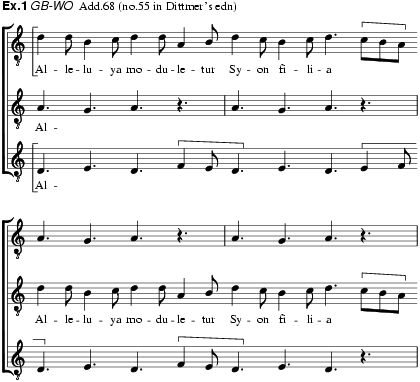
(fl ?late 13th century). English composer of many polyphonic alleluia settings, most of which are no longer extant but a list of which still survives. A ‘W. de Wicb’ was apparently scribe of many manuscripts during a four-year stay at the priory of Leominster in Herefordshire probably in the later 1270s (according to references in GB-Ob Bod.125, ff.98v and 99r). Among items listed in this source are a collectarium according to Reading use, written at the behest of the subprior, R. of Worcester (Leominster had been a cell, or dependency, of Reading Abbey since the reign of Henry I); a precentor’s work book (‘that is to say, a troper and processional in one’); a ‘summary [compotum] together with a treatise on music’; a ‘history [historiam] of St Margaret’, of which ‘Hugo de Wicb’ was the author and to which W. de Wycombe had added music; two rotuli containing polyphony, and many other books. W. de Wycombe, who seems to have compiled this list himself, made it clear that for part of those four years he occupied the priory’s leading musical position, that of precentor.
The same name occurs in the Reading manuscript containing the rota Sumer is icumen in (GB-Lbl Harl.978). It heads the second of the seven groups of compositions in the list of contents of W. de Wintonia’s book, a group consisting of 37 polyphonic alleluia settings composed by ‘W. de Wic’. Two such compositions are partly preserved on fragments of a rotulus (Ob Rawl.c400*), which may well have been one of the rotuli mentioned in Ob Bod.125; bits and pieces of three others are found among the so-called Worcester Fragments (see Worcester polyphony), where parts of 11 such compositions survive. Their attribution to W. de Wycombe seems entirely consistent with the available evidence. The list in Lbl Harl.978 and the extant fragmentary compositions together account for over 40 alleluia settings, constituting a cycle of Leoninian scope, most – probably all – of it composed by W. de Wycombe. It is a characteristic aspect of the lamentable state of preservation of medieval English polyphony that only one of these settings is entirely restorable (the setting of Alleluia, Dies sanctificatus; ed. in PMFC, xiv, 1979, no.70).
Since several of these compositions were found at Worcester, it has been suggested that ‘Wicb’ should be expanded into ‘Winchcomb’, as a Willelmus de Winchecumbe is mentioned in the Worcester Annals (Dittmer, 1954); he was a sub-deacon at the cathedral priory, was presented to St Andrew’s in Worcester in 1282 and instituted there the following year. However, the designation of a Benedictine monk as parish priest – unusual at any time in the later Middle Ages – was virtually impossible in England at that time, quite apart from the fact that Willelmus de Winchecumbe is nowhere identified as ‘frater’, and therefore was doubtless a secular cleric.
The alleluia settings are quadripartite pieces, whose second and fourth sections respectively set the solo portions of the respond and verse. Each is preceded by a free section of varying length. Section one is an introductory polyphonic trope to the respond; section three functions similarly to the respond; the resultant form is thus: trope – respond – trope – verse.
Each setting displays a certain tonal and thematic design. Sections one and two are tonally linked, the coda of the first section serving where necessary as a modulatory ‘bridge’; moreover, the pes of section one is quite often related to the incipit of the Gregorian respond. The third section is often thematically related to the first (though generally far shorter) as well as being tonally linked to section four – which is usually about twice as long as the first three sections combined. Some of the chant melismas are textually troped by one or both of the upper voices; this is always arranged so as to permit the simultaneous declamation of the liturgical syllables by all the voices. In several pieces the cantus firmus is actually changed in order to yield a tonally unified tenor.
The first section invariably involves voice-exchange (over a pes) or rondellus technique. One of them is in effect as fine a voice-exchange motet as can be found among the independent pieces composed in this manner; indeed, it evidently came to be detached from its alleluia, since it occurs as a separate motet in the Montpellier manuscript (F-MOf H196, no.322).
Ex.1 shows the stylistic indebtedness of the introductory tropes to the musical tradition culminating in Sumer is icumen in. Since the Summer canon and the list of contents of W. de Wintonia’s manuscript appear in the same source, it is even conceivable that W. de Wycombe composed the rota itself, a good many years before he was sent to Leominster; several years later he evidently originated the idea of adding freely composed voice-exchange polyphony as tropes to cantus-firmus settings. W. de Wintonia’s manuscript was then compiled some time after both men returned to Reading from their service at Reading’s cell in Herefordshire.

F. Ludwig: Repertorium organorum recentioris et motetorum vetustissimi stili, i/1 (Halle, 1910/R), 270ff [edn of list in GB-Lbl Harl.978]
F. Madan: ‘The Literary Work of a Benedictine Monk at Leominster in the Thirteenth Century’, Bodleian Quarterly Record, iv (1924), 168–70
B. Schofield: ‘The Provenance and Date of “Sumer is icumen in”’, MR, ix (1948), 81–6
J. Handschin: ‘The Summer Canon and its Background, I’, MD, iii (1949), 55–94
L.A. Dittmer: ‘An English discantuum volumen’, MD, viii (1954), 19–58, esp. 29–34
A. Hughes: ‘The Topography of English Mediaeval Polyphony’, In memoriam Jacques Handschin, ed. H. Anglès and others (Strasbourg, 1962), 127–39
E.H. Sanders: ‘Tonal Aspects of 13th-Century English Polyphony’, AcM, xxxvii (1965), 19–34
L.A. Dittmer: ‘The Lost Fragments of a Notre Dame Manuscript in Johannes Wolf’s Library’, Aspects of Medieval and Renaissance Music: a Birthday Offering to Gustave Reese, ed. J. LaRue and others (New York, 1966), 122–33
I.D. Bent: ‘A New Polyphonic “Verbum bonum et suave”’, ML, li (1970), 227–41
ERNEST H. SANDERS